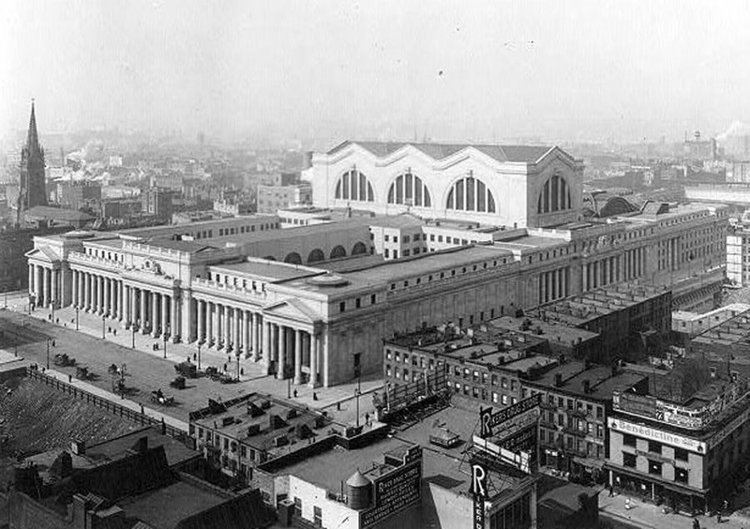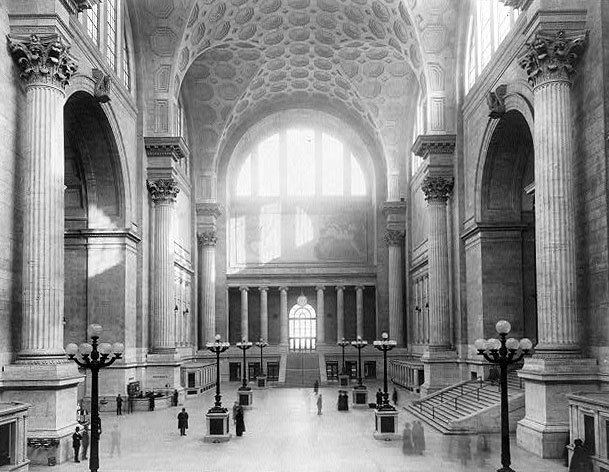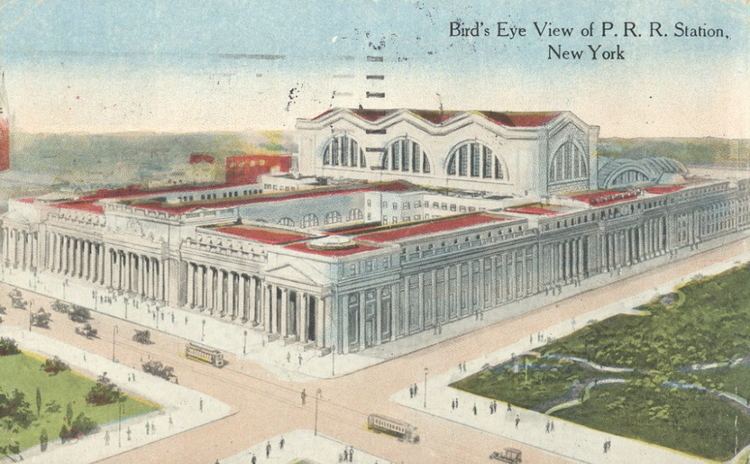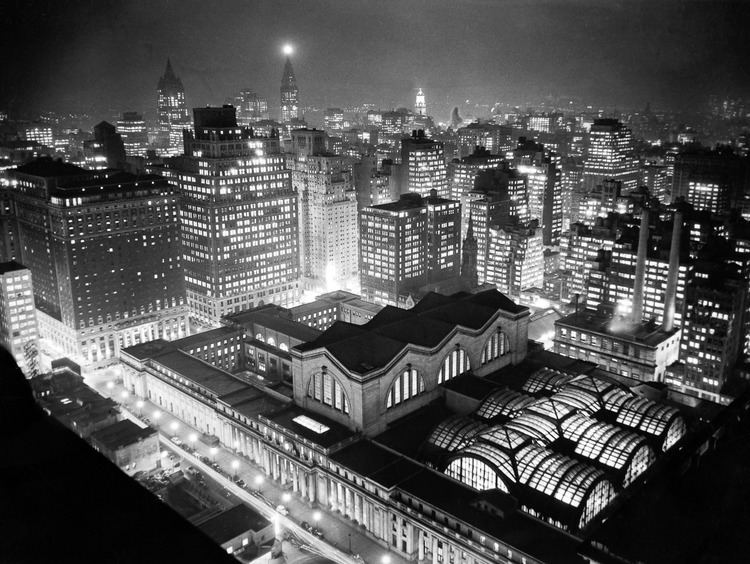Status Demolished Construction started 1904 Roof 45.72 m (150.0 ft) Opened 1910 | Completed 1910 Height 46 m Demolished 1964 Architecture firm McKim, Mead & White | |
 | ||
Similar James A Farley Post Office Bui, Singer Building, City Investing Building, Grand Central Terminal, Whippany Railway Museum | ||
Pennsylvania Station was a historic railroad station in New York City, named for the Pennsylvania Railroad, its builder and original tenant, and shared its name with several stations in other cities. It was designed by McKim, Mead, and White and completed in 1910. The original Pennsylvania Station head house and train shed were considered a masterpiece of the Beaux-Arts style and one of the architectural jewels of New York City. These above ground portions of the station were demolished in 1963.
Contents
- Planning and construction 19011910
- Operation 19101963
- Demolition 1963
- Present day
- Architecture and design
- Surviving elements
- References

Occupying two city blocks from Seventh Avenue to Eighth Avenue and from 31st to 33rd Streets, the original Pennsylvania Station building was 784 by 430 feet, covering an area of 8 acres (3.2 ha). It was one of the first rail terminals to separate arriving from departing passengers on two concourses.

As rail usage declined in the 1950s, the Pennsylvania Railroad sold the air rights to the property and downsized the railroad station. The above ground head house and train shed of the station were demolished and replaced by Madison Square Garden and Pennsylvania Plaza between 1963 and 1969. The destruction of Pennsylvania Station galvanized support for architectural preservation across the United States, leading to the advent of modern historical preservation. The below grade concourses and waiting areas were heavily renovated during this time. However, the boarding platforms at the lowest level remain virtually untouched.

Planning and construction (1901–1910)

The development of the station was championed by PRR President Alexander Johnston Cassatt, who led the overall planning effort for the New York Tunnel Extension project which included the station and the adjoining North River Tunnels and East River Tunnels. Cassatt was inspired by the Gare d'Orsay, a Beaux-Arts style station in Paris, though he planned for the new terminal to his railway to be twice as large.

Cassatt commissioned Charles McKim of the New York architectural firm McKim, Mead & White to design the terminal. McKim envisioned a space that would celebrate "the entrance to one of the great metropolitan cities of the world." He studied the role of public buildings in Ancient Rome, including the Baths of Caracalla. Cassatt and McKim worked closely together to define the structure of the station.

On November 27, 1910, after nine years of construction, Pennsylvania Station was opened to the public. The railroad paid tribute to Cassatt, who did not live to see the completion of his great edifice, with a statue designed by Adolph Alexander Weinman in the station's grand arcade. The statue, which was preserved and relocated within the modern station, was inscribed:
Operation (1910–1963)
During half a century of operation under Pennsylvania Railroad (1910–1963) scores of intercity passenger trains arrived and departed daily to Chicago and St. Louis on “Pennsy” rails and beyond on connecting railroads to Miami and the west. Along with Long Island Rail Road trains, Penn Station saw trains of the New Haven and the Lehigh Valley Railroads. A side effect of the tunneling project was to open the city up to the suburbs, and within 10 years of opening, two-thirds of the daily passengers coming through Penn Station were commuters. The station put the Pennsylvania Railroad at comparative advantage to its competitors offering service to the west and south. The Baltimore & Ohio, Central of New Jersey, Erie, and the Lackawanna railroads began their routes at terminals in Hoboken and Jersey City and Weehawken, requiring New York City travelers to use ferries or the interstate Hudson Tubes to traverse the Hudson River.
During World War I and the early 1920s rival Baltimore and Ohio Railroad (B&O) passenger trains to Washington, Chicago, and St. Louis also used Penn Station, initially by order of the United States Railroad Administration, until the Pennsylvania Railroad terminated the B&O's access in 1926. By 1945, at its peak, more than 100 million passengers a year traveled through Penn Station.
The station saw its heaviest use during World War II, but by the late-1950s intercity rail passenger volumes had declined dramatically with the coming of the Jet Age and the Interstate Highway System. After a renovation covered some of the grand columns with plastic and blocked off the spacious central hallway with a new ticket office, author Lewis Mumford wrote critically in The New Yorker in 1958 that “nothing further that could be done to the station could damage it.” History was to prove him wrong.
Demolition (1963)
The Pennsylvania Railroad optioned the air rights of Penn Station in the 1950s; at this time significant grime covered interiors and exteriors. The option called for the demolition of the head house and train shed, to be replaced by an office complex and a new sports complex. The tracks of the station, perhaps fifty feet below street level, would remain untouched. Plans for the new Penn Plaza and Madison Square Garden were announced in 1962 by Irving M. Felt, the president of Graham-Paige who purchased the air rights to Penn Station. In exchange for the air rights, the Pennsylvania Railroad would get a brand-new, air-conditioned, smaller station completely below street level at no cost, and a 25 percent stake in the new Madison Square Garden Complex.
A point made in the defense of the demolition of the old Penn Station at the time was that the cost of maintaining the old structure had become prohibitive. The question of whether it made sense to preserve a building, intended to be a cost-effective and functional piece of the city's infrastructure, simply as a monument to the past was raised in defense of the plans to demolish it. As a New York Times editorial critical of the demolition noted at the time, a "city gets what it wants, is willing to pay for, and ultimately deserves." Modern architects rushed to save the ornate building, although it was contrary to their own styles. They called the station a treasure and chanted "Don't Amputate – Renovate" at rallies. Despite the controversy generated over the demolition, the developer Irving M. Felt stated that he "believed that the gain from the new buildings and sports center would more than offset any aesthetic loss" and that "Fifty years from now, when its time for [the new Madison Square Garden] to be torn down, there will be a new group of architects who will protest."
Under the presidency of Pennsylvania Railroad's Stuart T. Saunders (who later headed ill-fated Penn Central Transportation), demolition of the above-ground station house began in October 1963. As most of the rail infrastructure was below street level, including the waiting room, concourses, and boarding platforms, rail service was maintained throughout demolition with only minor disruptions. Madison Square Garden and two office towers were built above the extensively renovated concourses and waiting area. A 1968 advertisement depicted architect Charles Luckman's model of the final plan for the Madison Square Garden Center complex.
The demolition of the head house—although considered by some to be justified as progressive at a time of declining rail passenger service—created international outrage. As dismantling of the structure began, The New York Times editorially lamented, "Until the first blow fell, no one was convinced that Penn Station really would be demolished, or that New York would permit this monumental act of vandalism against one of the largest and finest landmarks of its age of Roman elegance."
Its destruction left a lasting wound in the architectural consciousness of the city. A famous photograph by Eddie Hausner of the ruined sculpture "Day" by Adolph Alexander Weinman in a landfill of the New Jersey Meadowlands struck a guilty chord. One of the sculpted clock surrounds, whose figures were based on model Audrey Munson, still survives as the Eagle Scout Memorial Fountain in Kansas City, Missouri. Another clock sculpture, "Night," is in the sculpture garden at the Brooklyn Museum, and 14 of the 22 original eagle ornaments still exist. Ottawa's Union Station, built in 1912, a year after Penn Station, is another replica of the Baths of Caracalla; its departure hall now provides an idea of what the interior of Penn Station looked like (at half the scale). Chicago Union Station is also based on the design of these earlier structures.
The controversy over the demolition of such a well-known landmark, and its deplored replacement, is often cited as a catalyst for the architectural preservation movement in the United States. New laws were passed to restrict such demolition. Within the decade, Grand Central Terminal was protected under the city's new landmarks preservation act, a protection upheld by the courts in 1978 after a challenge by Grand Central's owner, Penn Central.
Present day
The current Penn Station is situated completely underground and is located underneath Madison Square Garden, 33rd Street, and Two Penn Plaza. The station spans three levels underground with the concourses located on the upper two levels and the train platforms located on the lowest level. The two levels of concourses, while original to the 1910 station, were extensively renovated during the construction of Madison Square Garden, and expanded in subsequent decades. The tracks and platforms are also largely original, except for some work connecting the station to the West Side Rail Yard and the Amtrak Empire Corridor serving Albany and Buffalo. There are presently three areas of the station, arranged into "Amtrak", "NJ Transit" and "LIRR" concourses.
Comparing the new and the old Penn Station, renowned Yale architectural historian Vincent Scully once wrote, "One entered the city like a god; one scuttles in now like a rat." This feeling, shared by many New Yorkers, has led to movements for a new Penn Station that could somehow atone for the loss of an architectural treasure.
Despite the improvements since the 1960s, Penn Station continues to be criticized as a low-ceilinged "catacomb" lacking charm, especially when compared to New York's much larger and more ornate Grand Central Terminal. The New York Times, in a November 2007 editorial supporting development of an enlarged railroad terminal, said that "Amtrak's beleaguered customers...now scurry through underground rooms bereft of light or character." Times transit reporter Michael M. Grynbaum later called Penn Station "the ugly stepchild of the city’s two great rail terminals."
Architecture and design
The original structure was made of pink granite and marked by an imposing, sober colonnade of Roman unfluted columns based on the classical Greek Doric order. The colonnades embodied the sophisticated integration of multiple functions and circulation of people and goods. McKim, Mead & White's Pennsylvania Station combined glass-and-steel train sheds and a magnificently proportioned concourse with a breathtaking monumental entrance to New York City.
From the street twin carriageways, modeled after Berlin's Brandenburg Gate, led to the two railroads the building served, the Pennsylvania and the Long Island Rail Road.
The main waiting room, inspired by the Roman Baths of Caracalla, approximated the scale of St. Peter's nave in Rome, expressed in a steel framework clad in plaster that imitated the lower wall portions of travertine. 150 feet high, it was the largest indoor space in New York City and one of the largest public spaces in the world. The Baltimore Sun said in April 2007 that the station was “as grand a corporate statement in stone, glass and sculpture as one could imagine.” Historian Jill Jonnes called the original edifice a “great Doric temple to transportation.”
Cassatt wanted to give passengers a cultural experience upon their arrival in New York. He modeled the arcade connecting the main waiting room to the Seventh Avenue exit after arcades in Milan and Naples, filling it with high-end boutiques and shops.
Surviving elements
Following the demolition beginning in 1963, much of the original elements have been lost, many buried in landfills in the New Jersey Meadowlands. Some elements were salvaged and relocated, some were over with modern finishes, and other assorted elements remain visible throughout the current station. Three eagles salvaged from the station exterior are known to remain in New York City: two in front of the Penn Plaza / Madison Square Garden complex, and one at The Cooper Union, Weinman's alma mater. Cooper's eagle had been located in the courtyard of the Albert Nerken School of Engineering at 51 Astor Place, but was relocated in the summer of 2009, along with the engineering school, to a new academic building at 41 Cooper Square. This eagle is no longer viewable from the street, as it is located on the building's green roof. Three are on Long Island: two at the United States Merchant Marine Academy in Kings Point and one at the Long Island Rail Road station in Hicksville, New York. Four reside on the Market Street Bridge in Philadelphia, Pennsylvania, across from that city's 30th Street Station. One is positioned near the end zone at the football field of Hampden-Sydney College near Farmville, Virginia. Yet another is located on the grounds of the National Zoo in Washington, D.C.
Other small architectural details remain in the station. Original stairwells with brass and iron handrails can be found leading between concourses, and down to track level, such as between tracks four and five. An original cast iron partition was uncovered during renovations, now separating a Long Island Rail Road waiting area from the hallway on the lower concourse. Original granite becomes exposed every so often in heavily trafficked area where modern flooring has worn, and the modern waiting areas and ticket booths occupy roughly the same spaces as the original 1910 configuration. From the track and platform level, glass pavers can still be seen embedded within the ceiling (the floor of the lower concourse) that once let light pass through the concourse from glass ceilings of the original train shed.
